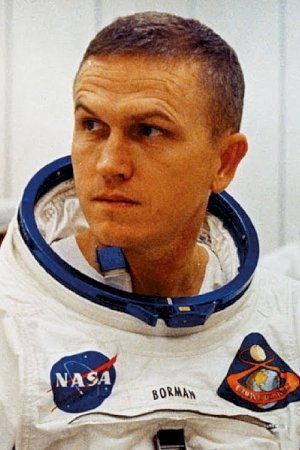Frank Borman

Frank Borman
Frank Frederick Borman II (born March 14, 1928) is a retired United States Air Force (USAF) colonel, aeronautical engineer, test pilot, businessman, rancher, and NASA astronaut. He was the commander of Apollo 8, the first mission to fly around the Moon, and together with crewmates Jim Lovell and Bill Anders, became the first of 24 humans to do so, for which he was awarded the Congressional Space Medal of Honor. As of 2020, he is the oldest living former American astronaut, eleven days older than Lovell. Four days before he graduated with the West Point class of 1950, in which he was ranked eighth out of 670, Borman was commissioned in the USAF. He qualified as a fighter pilot and served in the Philippines. He earned a Master of Science degree at the California Institute of Technology in 1957, and then became an assistant professor of thermodynamics and fluid mechanics at West Point. In 1960, he was selected for Class 60-C at the USAF Experimental Test Pilot School at Edwards Air Force Base in California and qualified as a test pilot. On graduation, he was accepted as one of five students in the first class at the Aerospace Research Pilot School. Borman was selected as a NASA astronaut with the second group, known as the Next Nine, in 1962. In 1966, he set a fourteen-day spaceflight endurance record as commander of Gemini 7. He served on the NASA review board which investigated the Apollo 1 fire, and then flew to the Moon with Apollo 8 in December 1968. The mission is known for the Earthrise photograph taken by Anders of the Earth rising above the lunar horizon as the Command/Service Module orbited the Moon, and for the reading from Genesis, which was televised to Earth from lunar orbit on Christmas Eve. During the Apollo 11 Moon landing mission, he was the NASA liaison at the White House, where he viewed the launch on television with President Richard Nixon. After retiring from NASA and the USAF in 1970, he became senior vice president for operations at Eastern Air Lines. He became chief executive officer of Eastern in 1975, and chairman of the board in 1976. Under his leadership, Eastern went through the four most profitable years in its history, but airline deregulation and additional debt that he took on to purchase new aircraft led to pay cuts and layoffs, and ultimately to conflict with unions, resulting in his resignation in 1986. He moved to Las Cruces, New Mexico, where he ran a Ford dealership with his son, Fred. In 1998, they bought a cattle ranch in Bighorn, Montana.